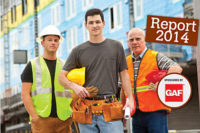
Bill Good, Executive Vice President of the National Roofing Contractors Association (NRCA), looks back on 2008 with mixed feelings. “I think we were pleasantly surprised we did as well as we did - especially in the nonresidential sector,” he said. “We only began to feel the real effects of the financial market crisis late in the year. Obviously, the residential market remains historically soft. We don’t see much of a rebound until at least the second half of 2009.”
“Many contractors have backlogs that will sustain them through the winter and even into spring,” he noted. “I’m afraid it will get tough after that, with lots of competition for any new work. All of the leading indicators suggest the commercial construction market will contract in 2009; roofing generally outperforms the construction industry (because of reroofing and repairs) but will still be sluggish. And again, the residential market is expected to stay soft until perhaps the third quarter, but the rebound will not be robust.”
Given this forecast, contractors should brace themselves for a tough 2009, said Good. “Contractors need to plan for a slowdown, which means: belt tightening; watching cash and collectibles; re-establishing relationships with current and previous customers; looking for service and maintenance opportunities; looking for opportunities to sell value, e.g., through energy savings.”
Asked what events might suddenly change the economic landscape, he replied: “For one thing, we could see an influx of government infrastructure spending that could help - and could give the green building movement some impetus. For another thing, we could see mortgage rates drop enough to stimulate home buying, where there is clearly some pent-up demand.”
“I’m afraid the more significant risks are on the downside, however,” he continued. “Until confidence is restored in our markets, a lot of cash will stay on the sidelines.
Despite the economic downturn, Good maintains the future for environmentally friendly systems is bright.
“We will definitely see more sophisticated roof systems, which incorporate some form of green technology - more insulation, reflective surfaces, garden systems and/or photovoltaics,” he said. “Even with lower oil prices, there’s no turning back. Also, the cost of money, while not going up, has to help. Low interest rates always help owners who are making expansion or renovation decisions.”
“I believe we are at a moment of transformation,” Good concluded. “First, there are a lot of people who instinctively think green - and are willing to pay for it. Second, we are on the verge of technology breakthroughs, especially with photovoltaics, that can change the way the industry behaves. Just imagine if roof systems have immediate payback periods because they are producing energy that not only powers buildings but can be sold back to the grid. And we have a new generation of architects who are looking to our industry for answers. The long-term outlook for the industry is extremely positive.”

Report Abusive Comment